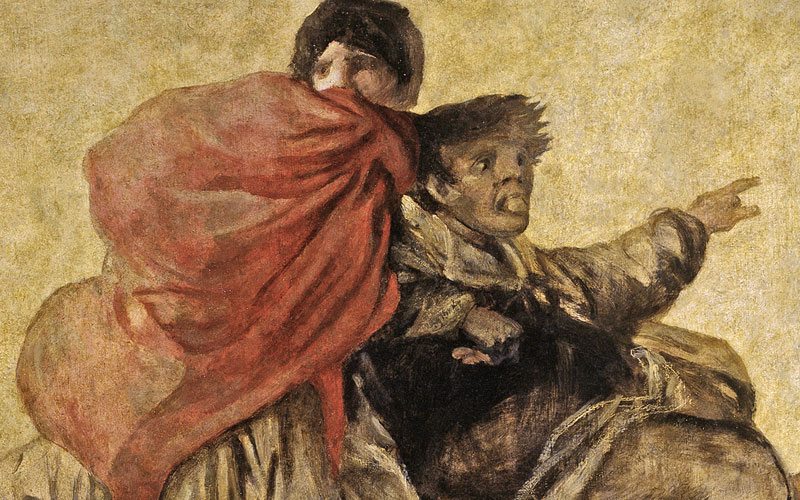The power of art lies neither in the image nor the emotions it arouses in the viewer, rather its greatness is derived from understanding the creative forces which inspired the masterpiece. Goya’s black paintings series is a great example that proves this theory.
Francisco Goya, the most important Spanish artist of late 18th and early 19th centuries, has been crowned by many as the last of the Old Masters and the father of modern art. The enigmatic and dark series, the Black Paintings, are the natural outcome of his life. The turbulent political times as well as a string of personal tragedies and illness shaped his thinking and marked the climax of his illustrious artistic career.
What drove Goya to paint such macabre, grisly images?
Are they the ravings of a mad man on the verge of insanity?
Or are they a grotesque mirror of human nature, chronicling overwhelming terror and despair?
By exploring Goya’s evolution from a highly ambitious commercial painter in the Spanish Court to a hermit painting, the solemn series of Black Paintings on the walls of his home, you will understand how his work and thoughts on human nature changed art forever.
Rags to Riches: From humble beginnings to royal painter
Growing up in Fuentedos, a small rural Spanish village, Goya initially learnt to paint by imitation. Looking to advance his skills, the aspiring young artist headed to Madrid. There, Francisco Bayeu, a court painter, took him under his wing and helped to pave Goya’s entry into the Royal Court of Madrid.
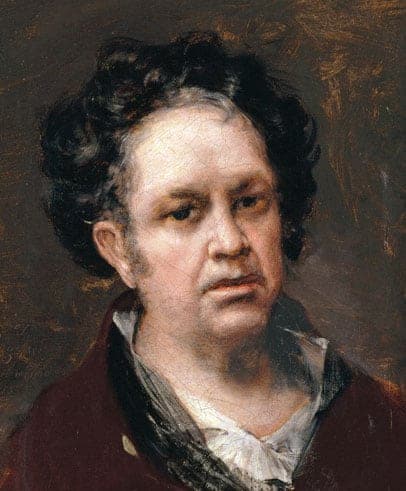
At first Goya painted cartoons for tapestries which would adorn the walls the royal palaces. As a tapestry designer, his work was infused with his fascination for common street life, alluding to his humble roots and primed him to be a keen observer of human nature. His earlier works were filled with street fairs, bar fights, swaggering majos, working-class men, and their sensuous majas, female partners etc.
As Goya won the royal favor, he steadily worked his way up the professional and social ladder and was commissioned to paint portraits for crowned princes, wealthy merchants, noblemen and aristocrats. Notable works include ‘The Nude Maja’, ‘The Clothed Maja’ and ‘The Family Of Charles IV Of Spain’.
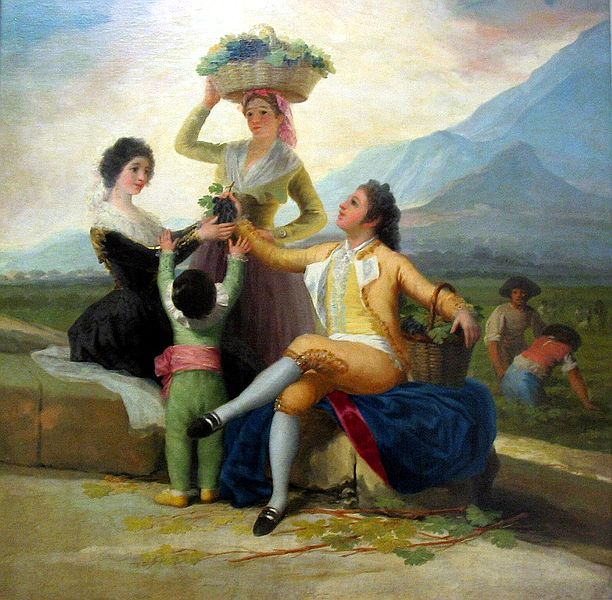
In 1786, he was appointed Painter-to-the King, the most prestigious position for a Spanish artist. In this role, Goya received a front row seat to the tumultuous political era which would leave an indelible mark on his work.
In 1792, at the peak of his career, Goya suffered from a mysterious illness, leaving him permanently deaf. Imprisoned in a tomb of silence, Goya distanced himself from society, becoming bitter and increasingly occupied with his own anxieties and fantasies. Many believe that the Black Paintings served as an outlet for his pent up frustration with his deafness and was a turning point in his outlook and artistic style.
More than his personal misfortunes, Goya’s shift in artistic and social world views was influenced by the political upheaval of the time.
At the turn of the 19th century, Napoleon Bonaparte invaded Spain. During this bloody period in Spanish history, Goya, continuing to serve as court painter to the reigning French, captured the horrors of war in ‘The Disasters of War’. These etchings chronicle the bloodcurdling savagery and violence of mankind in times of conflict. Having borne witness to the atrocities of which man is capable, Goya lost his faith in humanity and further withdrew from society.
In 1819, at the age of 73, Goya purchased a farmhouse on the outskirts of Madrid and retreated to the life of a recluse. The house, aptly nicknamed “Quinta del Sordo”, “House of the Deaf Man”, bore the name of the previous owner a farmhouse who was also deaf. It was on the walls of this house that Goya painted a series of 14 haunting works – the Black Paintings.
The Black Paintings: Self-expression of a tortured mind
Goya’s Black Paintings are the climax of his work as a painter. Through these frightful images, he expressed the fears which plagued him.
The nightmarish, demonic figures in the Black paintings, with gaping mouths and leering stares, stand in such stark contrast to the brightly colored paintings of his earlier career that some art historians have questioned whether Goya in fact painted the series.
His earlier portrayals of terror and violence, pale in comparison to the Black Paintings. Not only because Goya proceeded his time by exploring the human psyche, but because he did not intend for the images to be made public.
Goya was able to explore these themes of sorrow, pathos and panic with complete freedom. This is what makes Goya the first modernist of his time. He did not title his works, nor did he provide any explanation for them.
Following his death, the paintings were removed from the walls and may be seen today in the Prado Museum in Madrid. Even in the sanitized halls of the Prado, the monochromatic Black Paintings leave viewers unnerved. Here you go a quick brief of Goya’s black paintings
-
Atropos (The Fates)(Átropos/Las Parcas)
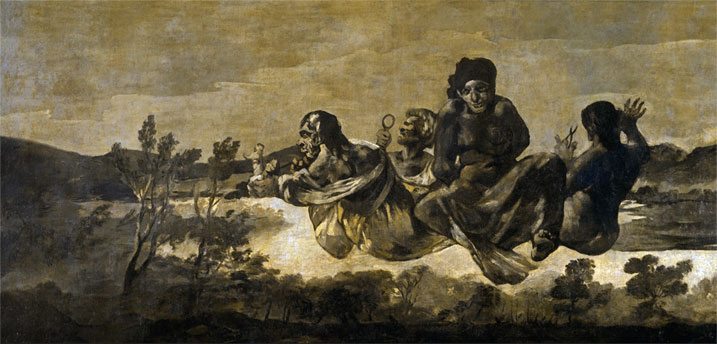
Three mythological figures (gods), clutch a pair of scissors, a demon and a mirror. The gods flank a fourth figure who is bound and is meant to represent the notion that one cannot escape destiny.
-
Two Old Men (Dos viejos/Un viejo y un fraile)
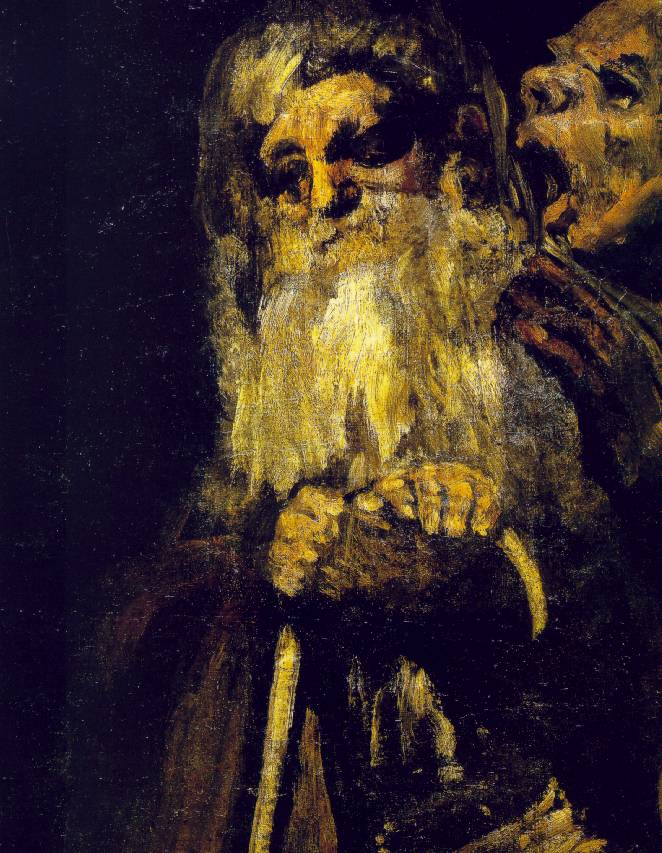
Two elderly men dressed in friar’s garb stand in darkness. The one, a demonic character, whispers into the ear of the second bearded man, who is hunched over a cane. The demonic figure may allude to Goya’s deafness or to insanity.
-
Two Old Men Eating Soup (Dos viejos comiendo sopa)
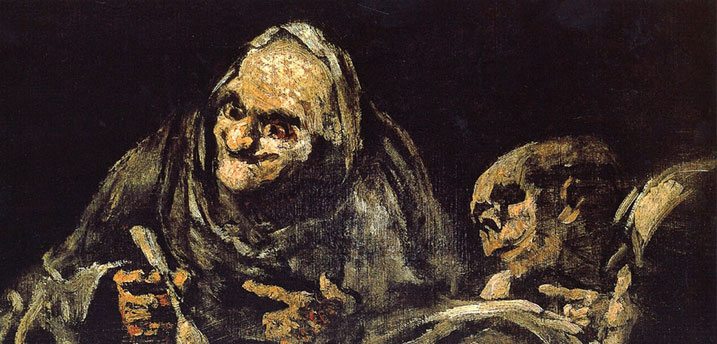
Painted in the same dark shades as other images in the series, the theme is not violent but arouses feelings of misery and despair. Two elderly figures, one bearing a devoid, toothless grimace, sit bent over their meal in a cloak of darkness.
-
Fight with Cudgels (Duelo a garrotazos/La riña)
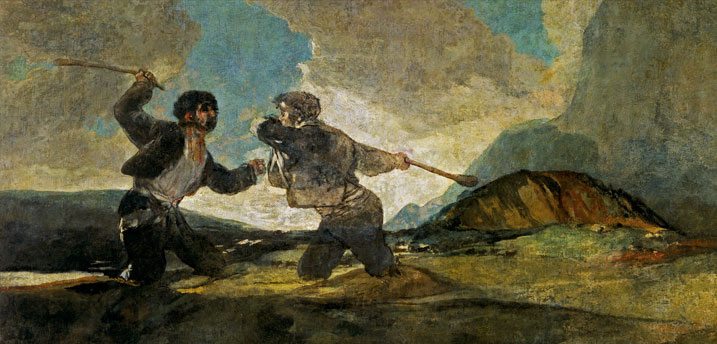
Two men, brandishing clubs in the air, rush at each other in conflict. The sparing pair seems to sink into a muddy bog as they fight.
-
Witches’ Sabbath (Aquelarre/El Gran Cabrón)

Satan, with the head of a male goat, lingers over a huddle of terrified witches. A withdrawn young girl sits in the corner apart from the quivering mass of bodies. Famous art historian, Licht believes that this painting was Goya’s reflection to physically convey anxiety at human inadequacy and his own feelings of personal doubt.
-
Men Reading (Hombres leyendo)
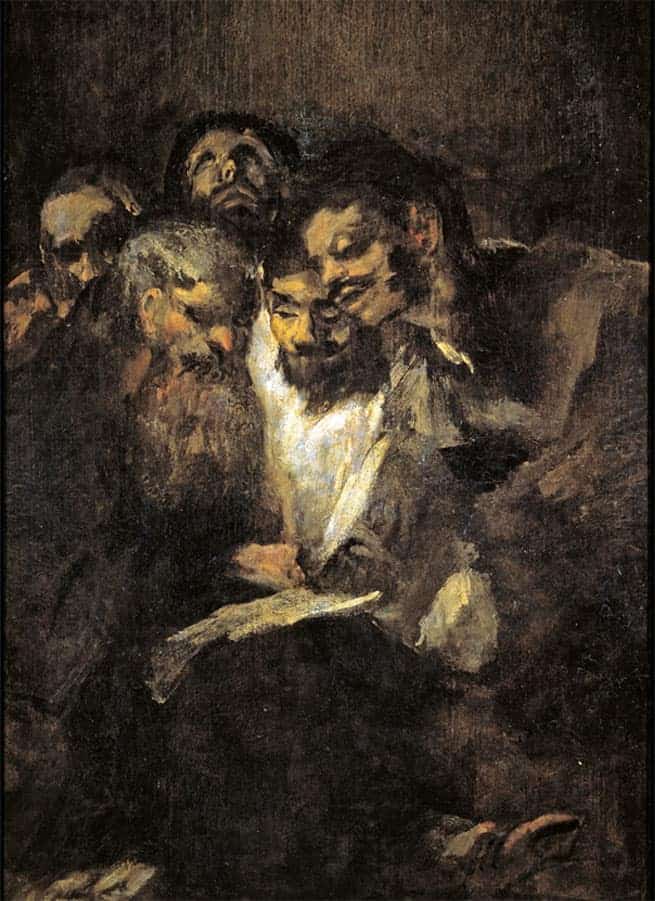
In this vertical image, a group of men, blanketed in darkness, huddle around a document. One of the men gazes upwards in a look of despair.
-
Judith and Holofernes (Judith y Holofernes)
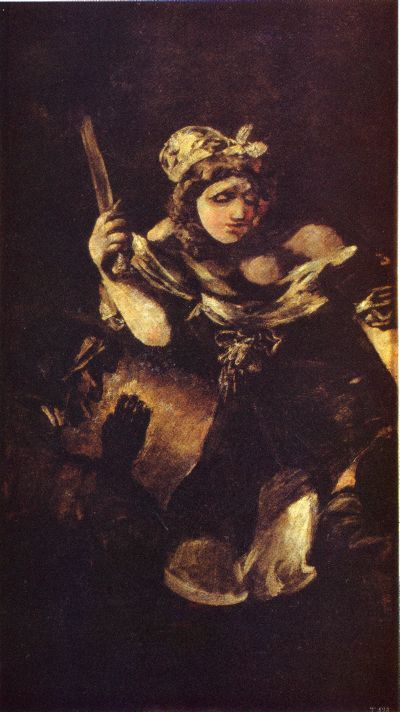
Judith and Holofernes black paintings goya
The painting is Goya’s personal interpretation of the narrative from the “Book of Judith”. In the story, Judith saves her people by seducing and beheading General Holofernes.
-
A Pilgrimage to San Isidro (La romería de San Isidro)

The painting shows the pilgrimage of poor villagers together with nuns and men wearing top hats. The pilgrims appear to be drunk or despairing, singing with distorted expressions. Goya explores the subject of pilgrimage to convey the popular superstitions and ignorance
- Men Mocked by Two Women (Mujeres riendo)

Two women, perhaps prostitutes, jeer with mocking expressions at a man who sits masturbating. The image is closely linked to another work in the Black Paintings series, ‘Men Reading’.
-
Procession of the Holy Office (Peregrinación a la fuente de San Isidro/Procesión del Santo Oficio)
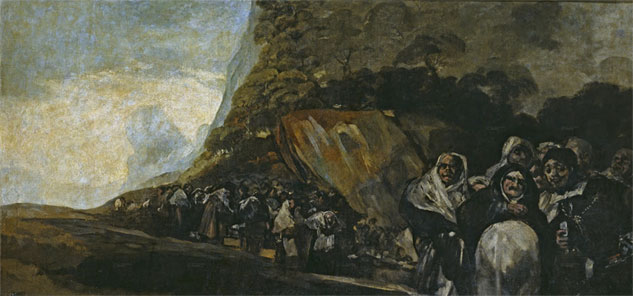
Procession of the Holy Office black paintings goya
A procession of hunched over figures, predominately white-scarved women, wind their way around a mountainous path. The sky is brightly lit, yet the figures are encased in hues of browns, blacks, and grays.
-
The Dog (Perro semihundido/El perro)

A forlorn looking black dog pokes his head out above a dirt mound. The dog is lost in the emptiness of the image which is vacant except for the sloping mound which conceals him. There are many interpretations of Goya’s intentions, one of which is, the work represents the man’s trivial struggle against malicious forces; the dog continues her fights but the sloping mass is burying her under sand
-
Saturn Devouring His Son (Saturno devorando a un hijo)
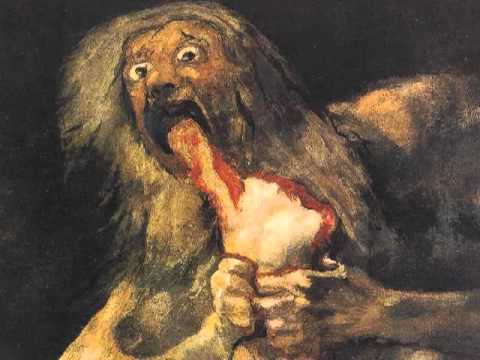
Inspired by Greek mythology, Saturn devours one of his children in fear that his offspring will one day usurp him. The ancient god with bulging eyes rips into the flesh of a small bloody body.
-
La Leocadia (The Seductress)
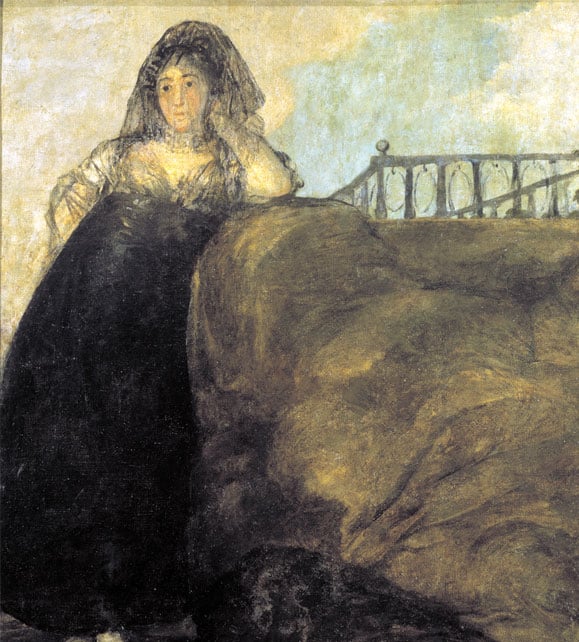
Leocadia Weiss, Goya’s housemaid and possibly his lover, leans against a mantelpiece or burial mound. Dressed in black funeral garb, she gazes at the viewer with a dejected expression, however, this work is more peaceful in representation and persoanlity
-
Fantastic Vision (Visión fantástica/Asmodea)
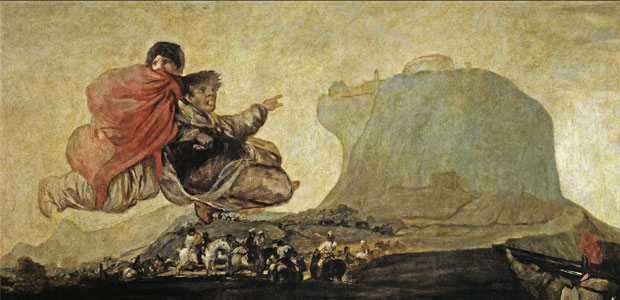
Two figures, one shrouded in red, hover over a group of people and horses congregating beneath a large mountain. At the bottom of a frame, an armed soldier raises his rifle towards the figures as they appear to float towards a fortress at the top of the mountain. Goya’s versatility in applying diverse techniques on the canvas is reflected work in this work
Goya’s Black Paintings: Inspiration for future generations
The Black Paintings serve as a cornerstone to Expressionism and Surrealism, influencing the works of Picasso, Manet and other great masters of the 20th century.
Francisco Goya’s dark paintings have left an indelible mark on the art world, influencing subsequent generations of artists, including the enigmatic Salvador Dali. we can explore the profound connections between these two visionary artists, unveiling the depths of human emotion and the allure of the surreal.
Today, although we are exposed to images of gore, misery and grief, much of it is sanitized and censored. Goya, on the other hand, unabashedly captures human trauma and sorrow in paint.
Deeply scarred by the times and by personal hardships, the Black Paintings serve as a cathartic expression of his unfiltered views of human nature. It is inspiring to see how the artist evolved from a painter seeking to please his patrons to an uninhibited artist who uses his art as the purest form of self-expression.
His works and their raw scrutiny of the human spirit remain just as relevant today. Respect Goya!


